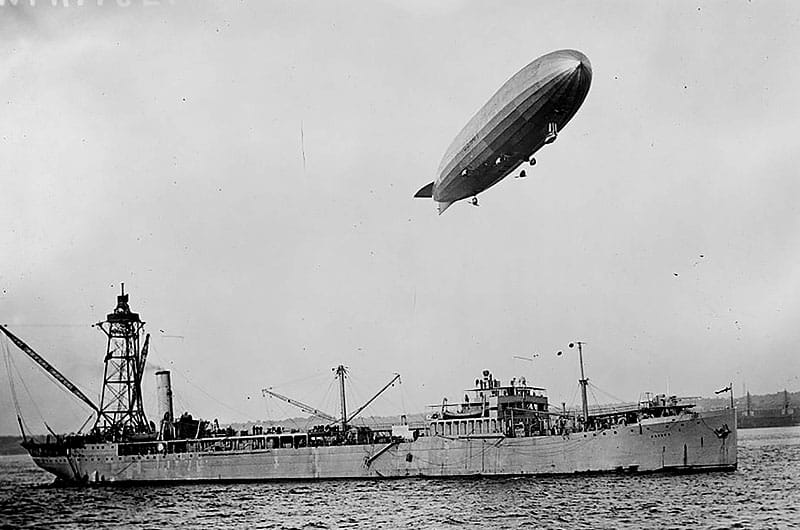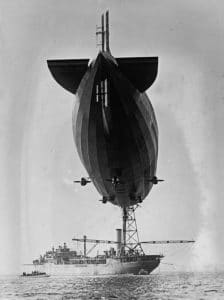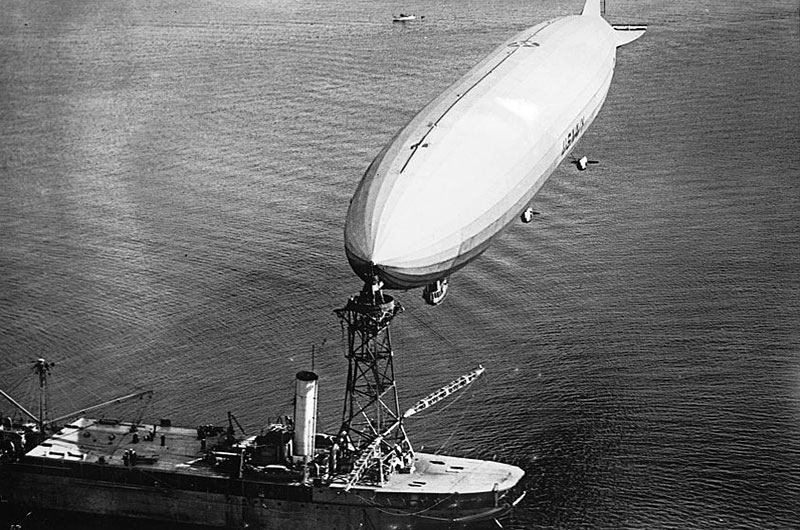~ by Amy Jenness ~

For centuries Nantucket mariners used the ocean as a global superhighway that took them away on business ventures to almost every continent. But when the United States entered World War I, the island’s culture of the sea shifted to the sky.
The months around the April 1917 announcement of war were tumultuous ones. German submarines attacked ships all along the east coast, with some occurring within miles of Nantucket. The US Navy took control the local lightships and the Marconi wireless station in Siasconset. It also expanded its Chatham base on Cape Cod and by 1918 Chatham had 525 men, 18 seaplanes, kite balloons, and two airships, also known as dirigibles.
For a few decades in the 20th Century hydrogen-filled dirigibles were considered the future of air travel, first for the military and later the public. In 1929 a German-made Zeppelin airship flew around the world for the first time, which established a market for intercontinental airship travel that lasted until tragic explosion of the Hindenberg in 1937.
Nantucketers experienced their first dirigible visit in 1918. The Inquirer & Mirror published this report:
“The big air-craft sailed gracefully across the Sound, and when it hovered over Wauwinet it took a straight course down the harbor, being overhead at noon and giving the islanders who were aware of its approach an excellent view of it, as at one time it was flying only about 300 feet high. The dirigible sailed around over the harbor, made a couple of long sweeps, and then went over towards Brant point, following the shore line along, sometimes moving rapidly and sometimes slowly, rising and falling as the aviators put it through the different experimental tests. The balloon followed the north shore of the island and gradually passed out of sight to the westward.”
In those early years, local dirigibles experienced crashes and malfunctions and Nantucket boats were called upon to rescue their crews. But the navy continued and Nantucket was often in the mix as a destination and support base. In 1924 a small fleet of navy seaplanes and the tender Patoka spent a month anchored at Nantucket while pilots trained with the dirigible Shenandoah off shore. And, in January of 1925 the navy flew a dirigible over Nantucket during an eclipse of the sun to take observations.

Germany, which pioneered the airship technology and used it effectively in the war, gave the United States dirigibles as part of their war reparations. One ship, the 654 foot Los Angeles, was sent to Nantucket annually in the early 1930s to assist calibration efforts at the US Radio Compass Station at Surfside, located in the former Lifesaving Station. The compass station emitted a radio signal for passing ships to use for navigation.
The Inquirer & Mirror reported on the visit 1931 visit, “From the south tower, Wednesday morning, we saw a sight which we had never seen before: Four lightships could be discerned in the offing, three steamers were ploughing their way through the sound, a fleet of quahaug boats were at work on the beds near Tuckernuck shoal, and over from the northwest came a speedy Navy plane, while a little farther to the westward the big dirigible Los Angeles glistened in the sun-light. But there was not a schooner in sight anywhere!”
In 1929 the New York Times ran a feature story on the historic round-theworld flight of the German dirigible Graf Zeppelin under the headline “From Nantucket to the Urals and From Tomsk to Tokio.” The Nantucket wireless station was the ship’s last American point of contact before it headed across the sea on its historic run.
Backed by newspaper mogul William Randolph Hearst, the Graf Zeppelin left Lakehurst Naval Air Station in New Jersey on August 7 and flew around the world, making it the first successful trans-Atlantic flight ever made. Over the next eight years the Zeppelin Company set the standard for intercontinental travel and flew more than 1,056,000 miles, made 590 flights, and carried 13,110 passengers.
Germans airships were designed to be lifted by helium gas, which is not flammable. But America controlled access to most of the world’s helium supply and banned its exportation in 1927. The Germans used hydrogen instead, which is lighter than helium, but also ignites easily. On May 6, 1937 the German dirigible Hindenberg caught fire and exploded while trying to dock in New Jersey. The accident killed 37 people and images of its fiery demise in newspapers and on movie newsreels shocked the world. The public lost its desire for commercial dirigible air travel and the huge airships never gained their foothold back.
The navy’s last Nantucket dirigible mission occurred in 1938 when a ship named TC-1J passed over the town flying so low that a man could be seen waving a handkerchief from one of the windows. It circled around for the morning while it calibrated with the compass station and then flew to Martha’s Vineyard.
The island’s brief involvement with dirigibles had ended, but Nantucketers, and the nation, had caught the bug for aviation. In 1918, The town built a pier for seaplanes to tie up. In 1927 the island’s first airport opened in Tom Nevers and offered commercial air service to Boston. Today, the Nantucket Memorial Airport is one of the busiest airports in the state and on peak days can record more landings and take offs than Boston’s Logan Airport.
Amy Jenness is author of On This Day in Nantucket History.



